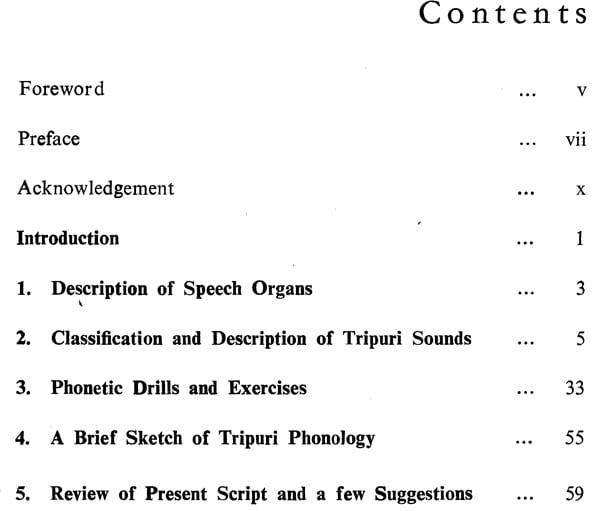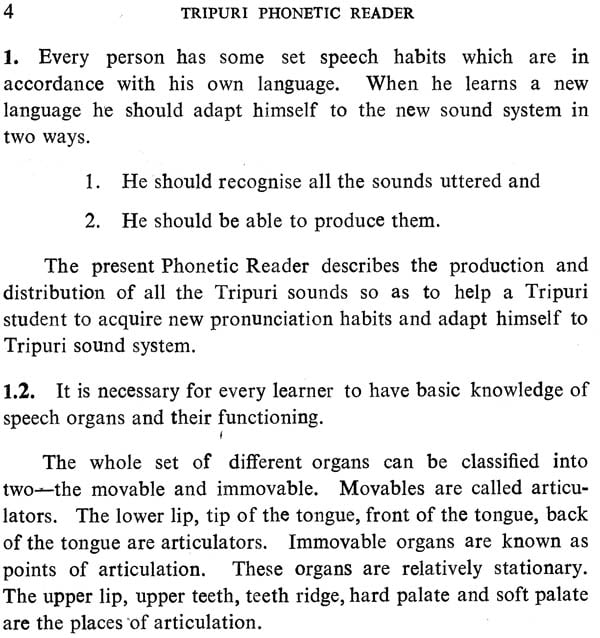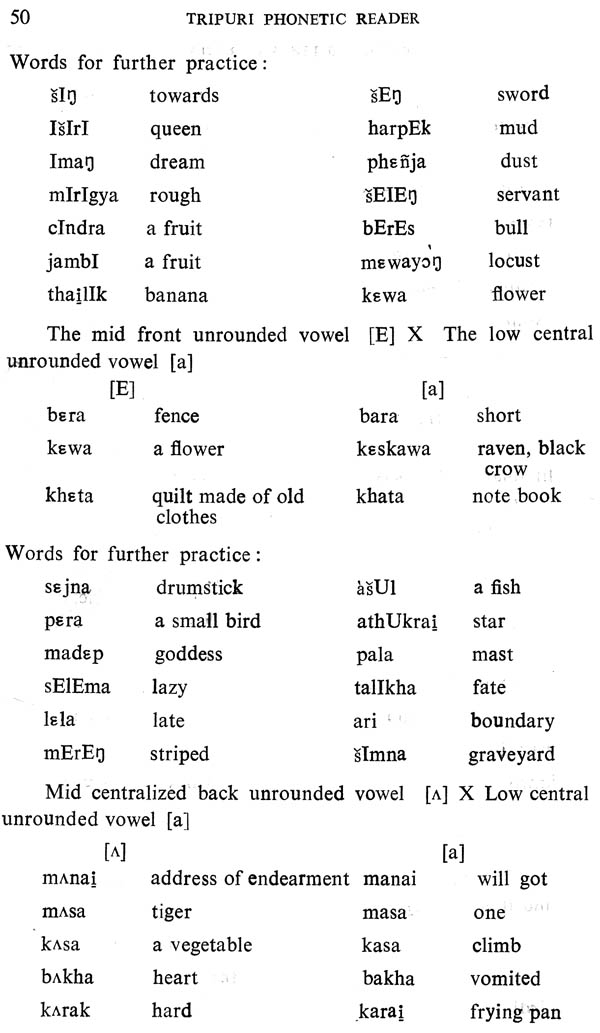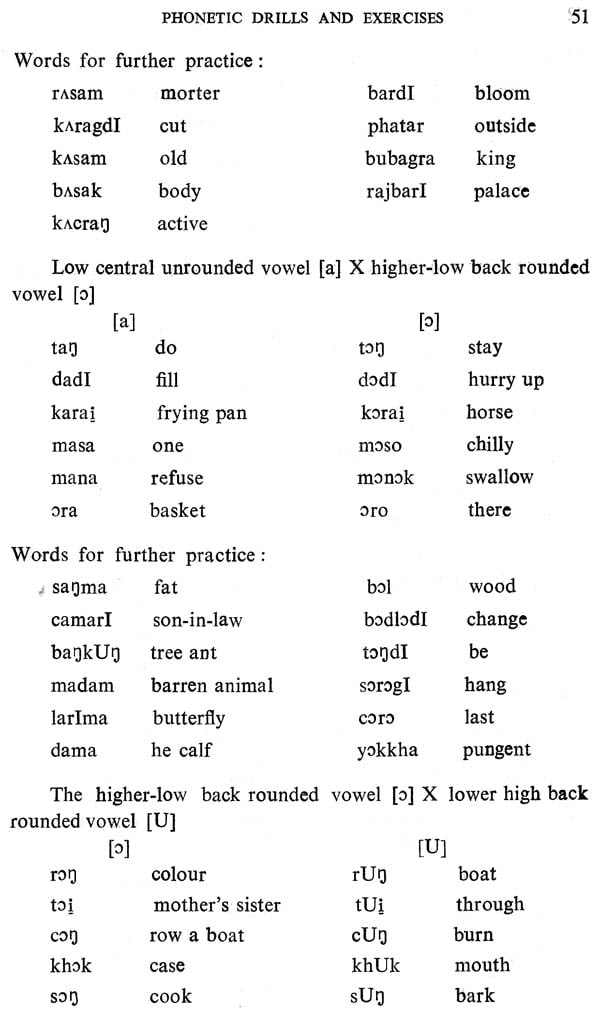
Tripuri Phonetic Reader (An Old and Rare Book)
Book Specification
| Item Code: | NAW245 |
| Author: | Pushpa Karapurkar |
| Publisher: | Central Institute Of Indian Languages, Mysore |
| Language: | Tripuri and English |
| Edition: | 1972 |
| Pages: | 76 |
| Cover: | PAPERBACK |
| Other Details | 8.50 X 5.50 inch |
| Weight | 100 gm |
Book Description
The Central Institute of Indian Languages was set up on the 17th July, 1969 with a view to assisting and co-ordinating the development of Indian languages. The Institute was charged with the responsibility of serving as a nucleus to bring together all the research and literary out-put from the various linguistic streams to a common head and narrowing the gap between basic research and developmental research in the fields of languages and linguistics in India. The Institute and its four regional language centres are thus engaged in research and teaching which lead to the publication of a wide-ranging variety of materials. Preparation of materials designed for teaching/learning at different levels and suited to specific needs is one of the major areas of interest of the Institute. Basic research relating to the acquisition of language and study of language in its manifold psycho-social relations constitute another broad range of its interest. The publications will include materials produced by the members of the staff of the Central Institute of Indian Languages and its Regional Language Centres and associated scholars from universities and institutions, both Indian and foreign.
The Central Institute of Indian Languages has initiated the Primetime Reader Series in Indian languages with a view to presenting the range of phonetic variation obtaining in this sub-continent and demonstrating the closeness of language on the basis of phonetic patterning. These Readers are biased towards learning the sound systems of languages. Thus it is hoped that this series will be of interest to both scholars who are interested in phonetic studies and practical learners of languages who wish to make a beginning in their language study.
If these materials help solving the problems in the State and help in understanding the people speaking the language, then our efforts will be deemed to have been amply rewarded.
About six per cent of the population of India is tribal. There have been three views about how best they can be drawn into the main stream of our national life. One obvious way is not to draw them at all and leave them alone and preserve their culture and traditions intact as museum pieces. The other extreme view has been to sort of drown them in the mainstream and completely assimilate them. The third view is to see that the best in their traditions and cultures that is consistent with modern life is preserved and they are integrated so that they maintain their individuality and at the same time participate in and benefit by the modern developments. It is also the considered view of all the people that matter that these tribal’s should be integrated with the regional population amidst whom they live. This can be done only when they are approached through their own mother tongues. It is also obvious that it is impracticable to use their mother tongues throughout their education. Their mother tongues are to be used so that they can effectively be integrated into the regional population. This does not mean that they should forsake their mother tongues, but only means that they should gain native-like fluency in their respective regional languages as early as possible. It is for this purpose that their languages have, to be scientifically studied and grammatical sketches and vocabularies have to be prepared. The scripts of the regional languages have to be adopted for writing their languages. Primers and textbooks have to be prepared.
To do all this the expertise of the linguists of the country should be placed at the disposal of persons interested in the education of tribal’s. Administrators who come in frequent contact with the tribal’s have in learn to speak fluently the tribal language in question. Learning a language implies an acquisition of a good pronunciation.
Firstly, the learner must acquire the capacity to recognise readily without any error the various speech sounds occurring in the language he is learning. Secondly, he must acquire the capacity to produce them with the help of his own vocal organs. Thirdly, he must acquire the capacity to produce the individual speech sounds he has learnt in sequences. In addition to these three skills, which may be sufficient to gain a reasonable pronunciation, the learner, depending on his needs, has to get a mastery over the orthography of the language he is learning. This involves developing automatic associations between written forms and speech sounds.
The Phonetic Readers in this series have been designed with the above points in view. They are mainly intended to meet the needs of administrators who have to learn the language in question.
Each Reader consists of a brief exposition about the organs of speech and their functions. It also introduces some technical terms. Then each speech sound is described in detail giving the movements of the vocal organs. Each description is rounded off by the technical term for that sound. A brief phonemic statement which meaningfully groups the sounds described in the preceding sections is also appended. A statement about the correspondences between the phonemes of the language and the letters used to write them comes at the end. In this section suggestions for improvements in the existing orthography are made. In the case of languages which have not yet been written, suggestions for adopting the script of the regional language are made.
It may be too much to claim that these Readers are perfect. There are lacunae still to be filled up. The most conspicuous of these is the lack of information on intonation. Though it is true that certain features of pronunciation can only be learnt with the aid of a teacher, the utility of such Readers cannot be underestimated. It is hoped that these Readers will be useful to even persons other than those for whom they are intended.
Tripuri is spoken by eleven different tribes residing in Tripura showing a little or more difference in their speech. These tribes are 1) Debbarma, 2) Noatia, 3) Jamatia, 4) Koloi, 5) Laitong, 6) Karpong, 7) Dalong, 8) Aiang, 9) Dahula, 10) Mosom, 11) Rupini, 12) Riang, 13) Muslung. They all call their language as kok-borok-ma meaning ‘language of men.
Tripur1 belongs to Bodo subgroup of Tibeto-Burman family and shows a close affinity with the other languages of the same subgroup like Boro, Garo, Kachari etc.
The Debbarma dialect which was studied for the purpose is spoken by ruling class people. This dialect of Tripuri shows three variations — one that is spoken in the city of Agartala and Other two in its north and south respectively. The main difference between the northern and southern speech lies in the fact that where northerners use /u/ the southerners use /i/, e.g., /ru/ — give — /ri/, /hun/ - say — /hin/.
Similarly, the Agartala dialect does not have an unrounded back vowel /w/, which is present in both the other dialects. They replace /m/ with /u/ in their speech, e.g., /tuxk/, - /tuk/, /thwy/- /thuy/.
**Contents and Sample Pages**










